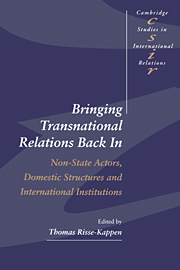 Bringing Transnational Relations Back In
Bringing Transnational Relations Back In Book contents
- Frontmatter
- Contents
- List of tables
- List of contributors
- Preface
- List of abbreviations
- Setting the agenda
- Case studies
- 2 Transnational relations and the development of European economic and monetary union
- 3 “Bullying,” “buying,” and “binding”: US–Japanese transnational relations and domestic structures
- 4 MNCs and developmentalism: domestic structure as an explanation for East Asian dynamism
- 5 Transnational relations, domestic structures, and security policy in the USSR and Russia
- 6 Mechanics of change: social movements, transnational coalitions, and the transformation processes in Eastern Europe
- 7 Ivory, conservation, and environmental transnational coalitions
- Conclusions: So what?
- Index
- CAMBRIDGE STUDIES IN INTERNATIONAL RELATIONS
7 - Ivory, conservation, and environmental transnational coalitions
Published online by Cambridge University Press: 02 December 2009
- Frontmatter
- Contents
- List of tables
- List of contributors
- Preface
- List of abbreviations
- Setting the agenda
- Case studies
- 2 Transnational relations and the development of European economic and monetary union
- 3 “Bullying,” “buying,” and “binding”: US–Japanese transnational relations and domestic structures
- 4 MNCs and developmentalism: domestic structure as an explanation for East Asian dynamism
- 5 Transnational relations, domestic structures, and security policy in the USSR and Russia
- 6 Mechanics of change: social movements, transnational coalitions, and the transformation processes in Eastern Europe
- 7 Ivory, conservation, and environmental transnational coalitions
- Conclusions: So what?
- Index
- CAMBRIDGE STUDIES IN INTERNATIONAL RELATIONS
Summary
Environment, development, trade
Five hundred years ago, 10 million elephants populated Africa's forests and savannas, from the shore of the Mediterranean almost to the tip of Cape Good Hope. Although estimates vary, today's elephant population is believed to be one-twentieth of that figure. Recently, in just one decade, the elephant population dropped nearly 50 percent, from an estimated 1.3 million in 1979 to 625,000 in 1989. At this rate, the elephant could be extinct in many parts of Africa by the end of the century.
Although habitat loss is the greatest long-term threat to the elephant, the principal immediate cause of elephant deaths in recent years has been poaching. After the Second World War, the demand for and price of ivory rose sharply, making poaching a very lucrative business. In the 1970s, many people invested in ivory as a hedge on worldwide inflation. Prices for raw ivory in Japan, Hong Kong, and Europe, the major ivory-consuming areas, rose from between $3 and $10 a pound in the 1960s to $50 a pound by the mid-1970s. In the 1980s, ivory sold for as much as $200 a pound. At the same time, Hong Kong improved its ability to mass-produce ivory carvings. Consequently, international ivory trade and thus, elephant killing, skyrocketed. According to one estimate, poachers were killing 200–300 elephants a day.
The decline in elephant populations can be characterized as having two interactive components. One is local, where property rights to elephant harvesting and maintenance are inadequately designated and enforced. The second is international, where high income growth has led to high demand for a precious commodity (ivory).
- Type
- Chapter
- Information
- Bringing Transnational Relations Back InNon-State Actors, Domestic Structures and International Institutions, pp. 227 - 254Publisher: Cambridge University PressPrint publication year: 1995
- 5
- Cited by


